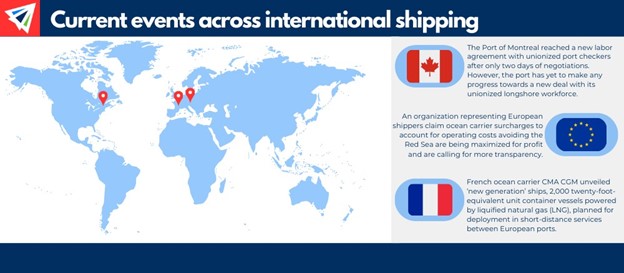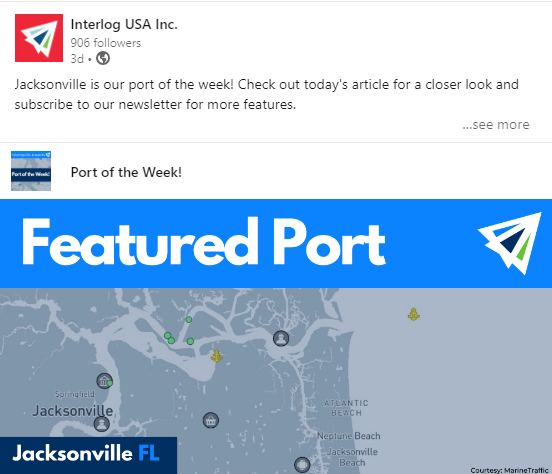Competitive Edge
February 28th, 2024
Stay Current with InterlogUSA
Latest Industry Happenings and Market Updates:

IMPORT: Asia to North America (TPEB)
Recent Developments:
- Pre-Lunar New Year bookings for Chinese imports were well above last year’s levels, according to an index from FreightWaves SONAR.
- While vessel congestion has not been a problem at East Coast ports, occasional episodes of vessel bunching have been reported the Port of New York and New Jersey. Read our archive of February’s Interlog Insights newsletter for more information!
Rates: Rates remain elevated but have levelled off from increasing further. They are disproportionately higher on containers bound for the East Coast.
Space: Space is mostly open but has tightened in pockets.
Capacity: Longer transit times around southern Africa (to avoid the Red Sea) are absorbing vessel capacity. However, carriers remain well-supplied with available vessels to manage the adjustment. There is no significant capacity crunch at this time.
TIPS:
- Hold your logistics partners accountable for frequent updates regarding current market conditions and routing impacts.
- Be flexible and adaptive to alternative service options, especially as it relates to potential savings on cost or transit.
IMPORT: Europe to North America (TAWB)
Recent Developments:
- Europe’s three largest container ports—Rotterdam, Antwerp, and Hamburg—have all reported sharp declines in volume for 2023. Their performances reflect a broader theme of economic anemia looming over Europe.
Rates: Rates have risen since the start of February. However, given this trade’s dormant demand, they are likely to retreat in the coming weeks.
Space: Space is open.
Capacity: Capacity remains abundant. Carriers are partially curbing this by reducing the size of vessels operating on transatlantic lanes. Though, significant blank sailing programs have not been implemented.
Equipment: Availability on both origin and destination sides, unless advised otherwise.
TIPS:
- Book at least three weeks prior to the ready date.
- Communicate with your logistics partners to ensure that you’re up to speed on the EU ETS program and its evolving impacts on transatlantic trade.
- Keep an eye on carrier discretion when it comes to their managing of the market. While this trade favors shippers at the moment, carriers could become more aggressive with tactics, like rate increases or blank sailings, to prevent further lossmaking.
EXPORT: North America to Asia
Rates: Rates have risen in mid-February.
Capacity: Space remains open, particularly from West Coast ports, however carriers remain curbing capacity via blank sailings and slow steaming as U.S. import demand remains challenged.
Equipment: There are no significant deficits or bottlenecks, however coordinate closely with logistics partners as conditions may vary case by case.
TIPS:
- Insufficient communication with sailing schedules can lead to higher detention and demurrage fees as well as higher trucking and storage costs. Ensure your logistics partners are not keeping you and your cargo in the dark.
Freight News
Biden Administration Announces Actions to Help Strengthen Cybersecurity at U.S. Ports
Last week the Biden Administration announced an Executive Order which will allow the Department of Homeland Security and the U.S. Coast Guard to have more authority in increasing cybersecurity at U.S. ports.
This Administration will invest $20 billion throughout the next five years in port infrastructure, according to Maritime-Executive. The Executive Order also addresses mandatory reporting of cyber incidents or active cyber threats – which includes threats to vessels, harbors, ports, or waterfront facilities.
Additionally, the U.S. Coast Guard will have authorization to control the movement of vessels that present a known or suspected cyber threat to U.S. maritime infrastructure. The USCG will also be able to inspect those vessels and facilities that pose a threat to U.S. cybersecurity – according to a White House press release.
Port of Savannah Planning to Reduce 'Free Time' Window - Starting July 1st
The Port of Savannah plans to reduce the ‘free time’ window for accepting export containers, starting July 1st. Outgoing containers will now only be permitted to arrive at the port seven days before a vessel’s scheduled departure, which will be down from their current nine days.
Regarding this change, “we are looking to align our export free time with our import free time,” Georgia Ports Authority spokesperson Tom Boyd told the JOC.
March 1st was the original date this reduced ‘free time’ window was set to go into effect, but exporters asked the Georgia Ports Authority for additional time, which the port agreed to. The port says they are working with those customers that are impacted by this upcoming change.

Port of the Week Winner: Port of Jacksonville
Every other Monday we post a poll on our LinkedIn page, where you can cast your vote on which port you would like to see featured in our deep dive on the following Friday.
Last Friday, the winner was the Port of Jacksonville. Click the button below to read the entire excerpt.
Consider subscribing to our biweekly “Port of the Week” newsletter to continue getting a closer look at various ports (and inland ports), globally and domestically.
Watch January's Webinar!
TOPICS: The State of Global Trade
– Updates on the Red Sea/Suez Canal and the Panama Canal
– Rates/Capacity, routing options, and how all, or any, of this impacts you.
We'd Love to Hear From You
Do you have an industry topic you’d like our experts to discuss in future webinars?
Let us know by clicking the button below to fill out a form or send us an
email at: support@interlogusa.coom
Interlog  Insights
Insights
Last week, we recapped our February Insights – you can view those here. Some topics that we discussed: U.S. – Asia trade agreement, Canal updates, and Labor uncertainty.
Our subscribers (it’s free to sign-up) are able to see our weekly insights every month in real time, when they get sent out every Friday at 10am CST.
Don’t miss out this Friday when we release our week one March Insights.
Sign up for our
industry answers
Our team works to provide valuable, unique, and relevant content to assist you in finding solutions. Sign up now.

